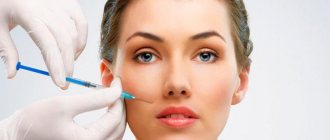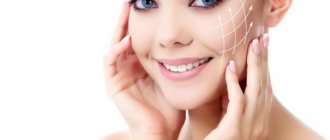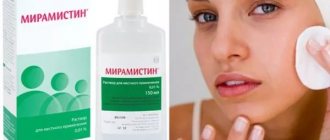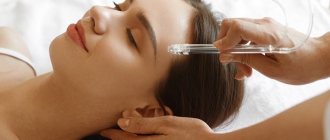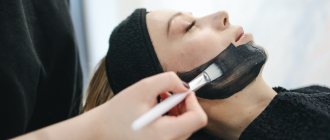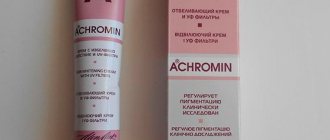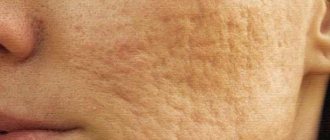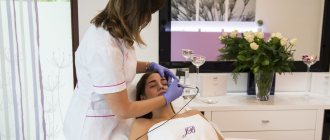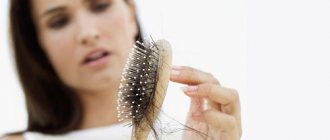Photorejuvenation is recommended for problems such as skin aging, rosacea, oily skin, rosacea, post-acne. The procedure has a number of contraindications:
- Open skin damage;
- Dark complexion;
- Pregnancy and lactation period;
- Diseases of the cardiovascular, endocrine system, lung diseases.
Also, the procedure cannot be performed for varicose veins, hormonal imbalance, cancer, tanned skin, photodermatosis and weakened immunity. It is not recommended to undergo photorejuvenation for herpes in the acute stage. The procedure is contraindicated for people with metal prostheses or wires, as well as pacemakers.
General idea and essence
Phototherapy (photorejuvenation) of the face is a new product on the market of cosmetic services that appeared about five years ago.
The essence of the method is the impact of a light beam of a certain frequency on the layers of the epidermis.
Using a special device, the doctor treats the desired areas of the face with a directed beam. In this case, depending on the purpose, layers both deep and on the surface of the skin may be affected.
The specialist’s task is to regulate the length and intensity of the light flux, pulse duration and frequency . These indicators are individual for each case.
In the skin layers, under the influence of heat and light, the formation of proteins of youth and beauty - collagen and elastin - is stimulated. This allows you to significantly increase the elasticity of tissues and strengthen the oval of the face.
In addition, the result of the procedure is the activation of metabolic processes in the cells of the epidermis. After such sessions, the skin is actively supplied with oxygen and is able to more intensively absorb all nutrients.
Information! Nourishing masks during facial phototherapy are more effective.
The effect of the sessions makes itself felt through pleasant changes - the face looks toned, fresher and younger.
List of contraindications
Photorejuvenation is safe and less traumatic, so it is suitable for almost all patients, which cannot be said about surgical lifting. Of course, there are age restrictions, because laser radiation can cause complications and negative effects in children and the elderly.
Direct contraindications are:
- period of pregnancy and lactation;
- severe chronic decompensated conditions;
- acute course of skin diseases;
- severe diseases of internal organs;
- serious mental disorders;
- exacerbation of herpes;
- oncopathology.
Indications and restrictions
The main indication for the use of facial phototherapy is the appearance of signs of age-related changes.
This procedure is applied if it is noted:
- decreased elasticity and tone of the skin;
- dull skin color;
- blurred oval face.
During its existence, the new method managed not only to remain in the arsenal of cosmetologists, but also to expand its scope.
Currently, phototherapy is also indicated in the following cases:
- the appearance of freckles or age spots;
- disease of the sebaceous glands, causing acne;
- dilated capillary vessels, so-called spider veins;
- dryness and flaking of the skin;
- enlarged pores.
In addition to the listed factors, other problems may be indications for a photorejuvenation session. For example, fine wrinkles or unhealthy complexion.
Often this procedure is carried out in combination with other hardware techniques (peeling, mesotherapy). Such combinations give good results in the process of skin treatment and rejuvenation.
If you choose phototherapy as a method of rejuvenation, you must familiarize yourself with the list of contraindications. These include:
- neoplasms;
- acute inflammatory processes;
- hypertonic disease;
- the period of bearing or feeding a child;
- viral infections;
- eye diseases;
- the possibility of epileptic seizures;
- diabetes;
- dysfunction of the thyroid gland;
- recent tanning (it is recommended to conduct a session after reducing its intensity);
- It is also recommended to avoid phototherapy for people with very dark skin.
Important! Before the session, you should pay attention to your psychological state. Stress or extreme anxiety can make the situation worse. In this case, treatment should be postponed until a more favorable time.
If at least one of the listed contraindications is identified, this procedure should be abandoned. This will allow you to avoid even bigger problems in the future.
Mechanism of action
The energy is supplied in separate beams, which are captured in the epidermis by special targets (more on them below). Their temperature increases and they collapse. An important nuance is that nothing happens to the tissues that surround them. That is, they maintain their integrity.
Such targets include:
- coloring pigment;
- iron-containing blood protein;
- pigments responsible for the level of photosensitivity;
- oxyhemoglobin;
- and other protein molecules.
The length of light waves that are used during photorejuvenation can reach 1400 nm. The targets, absorbing the energy of the sent pulse, heat up. As a result, this leads to the following processes:
- Melanin in skin cells is destroyed. Its color brightens. This helps get rid of increased pigmentation. Elastin and collagen fibers are destroyed and new molecules are formed. Externally, this is manifested by the improvement of complexion and skin turgor, and the pores narrowing.
- Small capillaries disappear, large ones become almost invisible, which helps to cope with many vascular pathologies. Connective tissue cells are activated, which begin to increase their number very quickly, promoting the formation of new collagen, elastin and hyaluronic acid.
- The procedure will be useful for people whose skin is susceptible to bacterial infection. As a result, the pathological flora is destroyed, and acne lesions are reduced.
One should not assume that photorejuvenation is a panacea for all age-related problems! There are some defects against which this manipulation is powerless!
Fighting freckles and pigmentation
Phenomena such as age spots (including freckles) are the most common reasons for using phototherapy.
In this case, a directed light flux affects any dark area, destroying the melanin present in it. After treatment, the pigment spot will begin to peel off, leaving behind a new layer of skin. In the future, it will be indistinguishable in color from the surrounding tissues.
Naturally, the desired result cannot be achieved in one procedure. The first visible effect can be observed 10 days after the treatment, when the pigment layer peels off.
Complete relief from freckles should be expected after 4-10 sessions. You should definitely take breaks between sessions, on average 2-3 weeks.
All of the above indicators are purely individual. The number of sessions, the duration of breaks between them, the intensity of the light flux and other nuances of the procedure are determined by the doctor. It focuses on the skin condition, age and problem of the patient.
For what purpose is oxygen mesotherapy prescribed and how effective is the technique? Visit here to learn more about fractional laser facial rejuvenation.
At this address https://cosmetolog-expert.ru/plastika-litsa/protseduryi/chto-takoe-elektroporatsiya.html you will find objective reviews about facial electroporation.
Expert opinion
- Cosmetologist
- Surgeon
Anna Avaliani
practicing cosmetologist
It is worth preparing for photorejuvenation. To do this, about a month before the manipulation, limit yourself to sunbathing in the sun or in a solarium. In addition, stop taking antibacterial agents, retinoids, and drugs such as Aspirin and Ibuprofen. Otherwise, there is a risk of complications. If there is no result, the procedure technique may have been violated, the doctor may have chosen the wrong filter, or the device has exhausted its service life. Remember that in the hands of an inexperienced cosmetologist you risk experiencing burns, scarring, and increased pigmentation.
Alison Pontius
plastic surgeon
Many people, having heard enough advertisements about the magical effects of photorejuvenation, expect more from the procedure than they receive.
Therefore, you should not expect a miracle and rejuvenation for several decades. The procedure does improve the condition of the skin and eliminates minor blemishes, but it will not lead to a radical transformation. To enhance the effect, it is worth approaching the problem comprehensively. To do this, I advise you to supplement photorejuvenation with mesotherapy, injection of fillers or another popular procedure. If you do not get the desired effect, and these manipulations are powerless against age-related changes, then plastic surgery will come to the rescue. We recommend watching a video on the topic:
So, the photorejuvenation procedure helps you look younger at almost no cost, get rid of age spots and spider veins on your face. However, it must be done after a full medical examination and do not skimp on the services of an experienced specialist.
Acne treatment
Acne (inflammation of the sebaceous glands) is a common problem for people subject to various hormonal fluctuations.
As a result of inflammatory processes, the accumulation and proliferation of pathogenic microorganisms occurs. This, in turn, leads to the appearance of acne. Advanced forms of this disease require long-term treatment.
In the fight against acne, phototherapy has proven to be an effective and quick method. The inflamed areas are treated with light pulses, causing them to heat up.
Temperature exposure causes the death of bacteria in areas of inflammation. At the same time, the production of proteins (collagen and elastin) increases. They promote healing and restoration of the skin.
Lasting results usually appear after 6-10 sessions. The interval between each procedure should be 2-3 weeks. The duration of the course and other treatment parameters are adjusted by the doctor based on the results of the work performed.
If the course of treatment was regular, then it should be expected that upon completion the patient will have a face without traces of acne.
What is photorejuvenation
The essence of this service is to combat age-related changes in appearance. Most often, photorejuvenation is used for the face - cheeks, forehead, chin, nasolabial triangle.
Laser photorejuvenation of the face promotes cell renewal and stimulation of collagen synthesis, due to which, as numerous reviews indicate, the skin becomes perfectly even, elastic, smooth, and fine wrinkles disappear.
For the procedure, the innovative M22 device is most often used, which produces pulsed light, which, acting on the face, removes dead cells of the upper layer of the dermis. The luminous flux does not contain the UV spectrum.
Facial photorejuvenation can be divided into four types:
- Elos. The technique combines electrical and photorejuvenation. Many cosmetologists believe that there is no alternative to Elos.
- Laser. The light source is a neodymium laser.
- Collagen. Collagen lamps are used to stimulate collagen synthesis.
- IPL devices for photorejuvenation. The use of powerful light pulses that affect the skin with frequent flashes of rays of a certain intensity.
A woman who decides to undergo photorejuvenation needs to consult with a cosmetologist who will advise which type of procedure is right for her. It should be noted that the price of the procedure also depends on the technique.
Description of the procedure.
The procedure must be preceded by a preparatory stage, otherwise the effect will be reduced or not achieved at all. So, a month before photorejuvenation, it is not recommended to visit the beach, solarium, or use self-tanning products. The doctor is obliged to find out whether there are contraindications.
Carrying out the procedure:
- The patient lies down on the couch.
- A special gel is applied to the treated areas of the skin, which has a cooling effect.
- The patient and the cosmetologist put on dark glasses. The flash is visible even through dark glasses, which creates some discomfort. With Elos rejuvenation there is no negative effect on the eyes.
- The cosmetologist begins to make laser flashes.
- At the end of the procedure (duration about an hour), the dermis is treated with panthenol.
Patients are often afraid that photorejuvenation may cause pain. Reviews from girls who have tried this procedure indicate some unpleasant sensations - tingling and burning, which are most often concentrated in the area of the lips and wings of the nose. Redness may be observed, which disappears within an hour and a half.
Undoubted advantages of photorejuvenation:
- when eliminating defects, the surface of the skin is not damaged;
- procedures have a cumulative effect.
Spider vein removal
Spider veins are a fairly common problem. It is especially relevant for people who have crossed the threshold of maturity.
A phototherapy session is one of the most effective methods of combating various forms of vascular disorders on the face.
In this case, under the influence of light and temperature, the walls of damaged vessels bond together. After this they disappear from the visible field of view.
The duration of treatment depends on the number and size of the affected vessels. On average, it varies from 6 to 8 procedures and is individual for each case.
Unfortunately, if this problem occurs once, then in the future it can be expected in other areas of the face, so it is recommended to perform 1-2 preventive sessions per month to prevent new spider veins.
What is yellow peeling and what problems can be solved with its help? This publication offers truthful reviews about darsonvalization of the face.
Here https://cosmetolog-expert.ru/plastika-litsa/protseduryi/udalenie-papillom-lazerom.html all the most important things about laser removal of papillomas and moles.
Rejuvenation procedure
Facial photorejuvenation is recommended to be carried out in a cosmetology salon with the help of a specialist.
Important! Before starting the procedure, the patient is obliged to warn the doctor about existing chronic diseases and the body’s reactions to specific drugs.
In this case, the following operating procedure is performed:
- Initial examination by a doctor. At this stage, the problem, skin type, and treatment parameters are determined.
- Makeup remover The facial skin is thoroughly cleansed.
- Treatment with protective gel. They cover the necessary areas to avoid burns. The patient also wears special glasses to avoid damaging the cornea of the eyes.
- Impact of a light beam on problem areas using the selected technology. The session lasts on average 20 minutes. Sometimes this period can be extended, depending on the condition of the skin and the degree of the disease. During treatment, a slight tingling sensation may be felt, but is not painful.
- Applying cooling cream. After the session is completed, the treated areas are covered with it to ensure a comfortable condition of the epidermis.
You should know that the effect of ultraviolet radiation on the skin in the form of photorejuvenation sessions is cumulative. Therefore, to achieve results, it is recommended to complete the full course of treatment agreed with your doctor.
Where to do facial photorejuvenation?
In aesthetic medicine, cosmetologists use light methods carefully, since if the skin type is incorrectly determined or the devices for the procedure are selected incorrectly, there is a high probability of developing complications. To avoid regretting your choice, contact only qualified doctors who have been specially trained and have gained relevant experience in photocosmetology
The Areado portal has collected the best cosmetology salons in Russia providing photorejuvenation services. To start selecting a salon in a suitable area or near a metro station, select one of the cities.
- Moscow;
- St. Petersburg;
- Novosibirsk;
- Yekaterinburg.
It is preferable if the cosmetologist is certified in the field of laser technology and has received a certificate from the manufacturer of the device with which he works. The light treatment device deserves special mention. The more modern the device used by the doctor, the higher the chances of a good effect for the patient.
Modern models are equipped with automatic high-precision diagnostics. This helps the cosmetologist select the appropriate intensity of the rays. Preset programs, replaceable filters and emitters allow the program to be adjusted for each patient. You can find out the name of the device by calling the clinic or looking at the website.
It is worth noting that the procedure will be more expensive when using professional equipment.
Expected Result
For many, the first results become noticeable after the first session. This is expressed in the acquisition of a fresher complexion, sometimes in a reduction in the severity of fine wrinkles.
More visible changes are observed after 4-5 photorejuvenation sessions.
During this period the following changes occur:
- skin elasticity is restored due to its saturation with collagen and elastin;
- age spots and freckles disappear;
- deeper wrinkles are smoothed out;
- the oval of the face is strengthened;
- inflammation on the face disappears;
- pores noticeably narrow;
- your complexion will look healthy.
Depending on the problem, age and condition of the skin, a full course of phototherapy can range from 6 to 10 sessions. At this stage, the patient also solves more complex problems on the face:
- Killoid scars resolve;
- neglected acne disappears;
- The “orange peel” effect decreases or completely disappears.
Including breaks, the full course of treatment takes up to six months. But given the possible results, this time cannot be called wasted.
Photos of patients before and after
Difficulties of recovery
In the absence of contraindications, the phototherapy procedure is safe and virtually painless.
Immediately after its completion, slight redness and swelling may appear on the skin. Crusts may appear at the site of the largest accumulations of blood vessels.
All described negative phenomena are optional, and if they occur, they disappear on their own within a few days.
To consolidate the effect obtained, you must adhere to certain rules. To do this you should:
- within 2-3 weeks after the procedure, use drugs for skin regeneration (panthenol or the like);
- When outdoors, apply sunscreen to your face;
- limit the consumption of alcohol and cigarettes;
- drink water daily in an amount of at least 1.5 liters;
- if necessary, limit the use of decorative cosmetics for the face;
- It is recommended to take vitamins (groups C and A).
There are also more categorical restrictions for this procedure:
- for the first two weeks you should not tan in the sun or in a solarium;
- avoid visiting the bathhouse, sauna and swimming pool;
- baths should not exceed body temperature.
Following these simple rules will make the photorejuvenation procedure useful and effective for a long time.
The video provides additional information on the topic of the article.
After the session: how to care for your skin
Interestingly, photorejuvenation does not require any special skin care measures after it. When the redness goes away, you can even use decorative cosmetics if necessary, although it is better to still let the skin “come to its senses.”
In some cases, the face may become swollen after photorejuvenation. If facial swelling does not go away within 1-2 days, you should contact the doctor who performed the procedure.
As part of post-procedure care, the affected areas should be periodically applied with a moisturizing cream with an antiseptic effect. In addition, they must be protected from direct sunlight during the entire course. It is also undesirable to visit the sauna, bathhouse and solarium.
Service price
The price range for such procedures is quite wide. A large number of factors influence the cost of a phototherapy session. These include:
- degree of disease;
- size of the treated area;
- modification and class of the device used;
- operating parameters (duration and number of flashes);
- drugs used.
On average, today one session of facial phototherapy can cost from 2,000 to 7,000 rubles.
More accurate information about prices can be found on the institution’s website or by calling the helpline.
Portable devices for home
Further development of the phototherapy method made it possible to use it at home independently. For this purpose, several types of portable devices for photorejuvenation have been developed and are already used.
The most common modifications are:
- Silk , n Reju is a French device of the latest generation. It has a built-in temperature sensor and turns off automatically after reaching the desired temperature. Used for facial skin rejuvenation.
- Quantum is a modern American device. The advantages of this device include versatility, efficiency and safety. At the same time, it has a minimum number of restrictions.
- Yakhroma-med is a domestically produced device. The principle of its operation is the effect of copper vapor on the skin. With its help, it is possible to treat a wide range of diseases of the skin of the face and other parts of the body.
Each of these devices has its own specific use. The procedure for using the device is reflected in the instructions included in the kit.
Before you start using it, you must carefully study all its points and strictly adhere to them in the future.
Advice. To gain skills in independent work, it will be useful to get advice from a professional or undergo a phototherapy session in a clinic.
